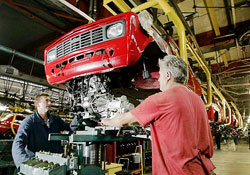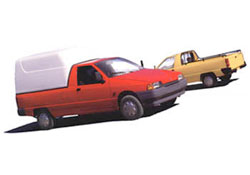
Through ingenuity and sheer force of will, Zastava production continued through a difficult period (Skala 55 line shown)

During the wartorn 1990s, average monthly wages at Zastava dip as low as $15. The Sana/ Florida, which has shown such promise, spends much of these years waiting for better times, and for the parts needed for its production. Just 24,000 cars are made in 1992, and 7,000 in each of 1993 and 1994.
The embargo imposed upon Yugoslavia is devastating to its industries. In addition to eliminating the country's industrial export markets, sanctions cause severe shortages of raw materials. In 1993, Serbia's industrial output and retail sales fall by 40% and 70% respectively. Approximately 60% of the industrial labor force in Serbia is laid off.
Still, the Zastava Group holds 47 companies, and continues to manufacture trucks; passenger cars; pick-ups, and special vehicles, as well as components. It employs, directly, 36,000 people overall, 20,000 in its hometown of Kragujevac. 13,000 work at the car factory; 3,000 at
Zastava Kamioni ("Zastava Trucks").
Gradually, Zastava begins to find domestic substitutes for the parts it can no longer import.

Maintaining production during the '90s was hard enough - but Zastava managed to continue vehicle development, too. The Florida Poly and pick-up models debuted toward the close of 1998
In 1995, the company shows a prototype Florida pick-up.
Zastava Specijalni Automobili ("Zastava Commercial Vehicles") of Sombor is charged with production logistics and, indeed, production begins, albeit toward the end of 1998. The vehicle offers cargo space of up to 3.48 cubic meters and, thanks to a redesigned rear suspension and subframe, is capable of carrying up to 700 kilograms.
A possible partnership deal with South Korea's Daewoo is bandied about. Zastava begins renegotiating with Fiat, and is in talks with Peugeot of France, in an attempt to establish a long-term partnership that would bring more work to Kragujevac, and help the company to rejoin the international automotive industry.
The ongoing economic embargo against Serbia will ultimately delay the results of these negotiations until 2002.
Undeterred, the Zastava Group produces 11,124 automobiles (2,725 Skala 101s; 1,757 Skala 128s; 5,157 Yugos; 585 Floridas, and 900 commercial vehicles) in 1997, and 14,011 in 1998. It plans to produce 25,000 passenger vehicles in 1999, versus 13,500 in 1998. It also aims to make 2,000 trucks, versus 200 in 1997.

A Yugo Euro concept is developed in 1998. Its engine is designed to be maintenance free for 124,000 miles
The Florida is on track again, with a more luxurious
Business version available for '99.
A Yugo Euro concept is developed with a 1.3-liter engine designed to be maintenance free for 124,000 miles. Tentatively, Zastava hopes to export it to the United States in March of 2000.
Yet 1999 will be among the worst years in Zastava's history.
Despite the turmoil, the Zastava power plant has continued to provide central heating for all of Kragujevac, whose schools; hospitals, and approximately 15,000 flats depend on its electricity; compressed air; hot water; industrial steam, and decarbonized and demineralized water.
This makes the plant a target, in a campaign which indifferently attacks both military and civilian installations across Serbia.

Zastava employees tenaciously formed a round-the-clock live shield against NATO aggression. To an extent, their attempts succeeded - but damage was nonetheless considerable

When in 1999 NATO bombs Zastava's facilities over two nights, nominally to weaken Serbia's resolve in a battle for control of its country's Kosovo province, Zastava's employees face a bleak outlook.
Many have formed a human shield inside and around the factory, writing in an open letter to NATO,
"we, the Zastava workers and citizens of Kragujevac, are afraid of the future ahead. "Now we wonder whether we have any future at all. Our children are hungry, and their eyes are filled with horror. We have no more answers to their questions."
Zastava's car factory; truck factory; power plant, and machine and tool foundries all suffer to varying degrees during the bombing. The facilities are hit twice, in the early mornings of Friday, April 9th (the Serbian Good Friday) and Monday, April 12th, with 21 missiles and bombs. 140 of Zastava's people are injured during the first raid, 30 heavily, while another 36 are injured in the second.
Damage to Zastava's power plant alone is estimated at 46 million deutsche marks, while the total estimated damage to the factories as a whole is figured at $500 million.
Zastava's forge factory, established in 1936, is among the hardest hit. It has been forging components for agricultural machines; trucks, and railways, exporting in limited quantities to Germany and the Czech Republic.
Yet perhaps the most significant problem for Zastava is the destruction of its paint shop, an automated line that had begun operation with the export of Yugos to the USA on July 10th, 1985. Robots had been provided by Siemens Germany; Jaco Italy, and Ralsberg Germany. All the ingenuity in the world cannot replace a Ralsberg belt, capable of thirty thousand revolutions per minute. The entire line will need to be rebuilt.
Zastava's $10 million computer center, consisting of two large IBM mainframes which have handled data for all Zastava factories throughout Serbia, is destroyed.
"If we include all the other factories throughout Serbia that are part of the Zastava Group, it is estimated that the living conditions of about 200,000 people are in jeopardy," notes a Zastava representative to a group of foreign journalists touring the damage. 60,000 people in Serbia are directly employed in car production, he adds.
120 suppliers face bankruptcy. Many a Western observer suggests that Zastava's ability to manufacture cars has been entirely eliminated.
Again, the company will pick up the pieces
Despite the predictions, and the gravity of the situation, Zastava's resilience will again prove unshakeable. A one hundred and forty-four year old industrial giant cannot be destroyed overnight.
Years later, in 2003, director Miljko Kokić would proudly tell the
Financial Times that Zastava workers had worked overtime to repair the damage, improvising to make up for ruined production lines.
"With sales rising and (monthly) salaries up to $150, they do not want to quit now... this factory is all we have," Kokić said.
"We had no choice but to move on, and get on with it," marketing director Vladeta Kostić would in 2005 explain to a somewhat incredulous Italian team visiting the factory for its
Planeta Zastava documentary.
Surveying the damage of '99, Zastava Group president Milan Beko was encouraged by offers of assistance from present and former business partners, and by the high morale demonstrated by factory employees who had continued to come to work each morning.
"As long as this is the situation, we shall overcome all difficulties, primarily through the help of our factory employees; the government, and our business partners," he promised.
By July 1999, thirty days after the end of debilitating, three-month-long air strikes, the Serbian government is already making plans to rebuild Zastava.
"By helping Zastava, we are helping the entire Serbian industry, because the plant has 226 subcontractors who are directly linked to it, not to mention an even larger number of indirect domestic producers," Serbian Prime Minister Mirko Marjanović tells Serbia's
Politika daily.
It is estimated that $87 million - and a lot of ingenuity and improvisation - will restart production. Milan Beko promises to fund part of the reconstruction effort through the sales of 3,500 vehicles remaining in Zastava's stock. The remaining 70% will be provided by the government, which would extend credits to the company via its fund for financing economic and social programs, and via the Serbian Development Fund.